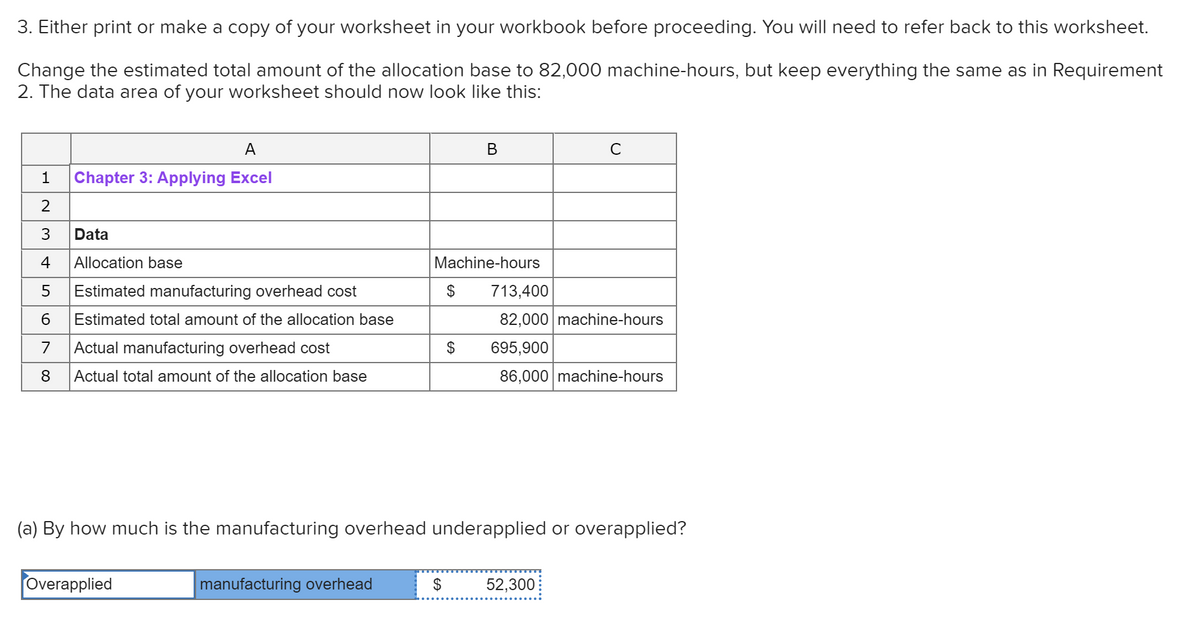(b) Why is the amount of underapplied (overapplied) manufacturing overhead different from Requirement 2 above? (You may select more than one answer. Single click the box with the question mark to produce a check mark for a correct answers and double click the box with the question mark to empty the box for a wrong answers. Any boxes left with a question mark will be automatically graded as incorrect.) ? The change in the estimated total amount of the allocation base affected the predetermined overhead rate. ? The change in the estimated total amount of the allocation base affected the amount of manufacturing overhead applied. ? Actual manufacturing overhead cost differs from period to period. ? The estimated manufacturing overhead cost did not change in proportion to the change in the estimated total amount of the allocation base.
(b) Why is the amount of underapplied (overapplied) manufacturing overhead different from Requirement 2 above? (You may select more than one answer. Single click the box with the question mark to produce a check mark for a correct answers and double click the box with the question mark to empty the box for a wrong answers. Any boxes left with a question mark will be automatically graded as incorrect.) ? The change in the estimated total amount of the allocation base affected the predetermined overhead rate. ? The change in the estimated total amount of the allocation base affected the amount of manufacturing overhead applied. ? Actual manufacturing overhead cost differs from period to period. ? The estimated manufacturing overhead cost did not change in proportion to the change in the estimated total amount of the allocation base.
Managerial Accounting: The Cornerstone of Business Decision-Making
7th Edition
ISBN:9781337115773
Author:Maryanne M. Mowen, Don R. Hansen, Dan L. Heitger
Publisher:Maryanne M. Mowen, Don R. Hansen, Dan L. Heitger
Chapter4: Job-order Costing And Overhead Application
Section: Chapter Questions
Problem 35BEB: Use the following information for Brief Exercises 4-34 and 4-35: Sanjay Company manufactures a...
Related questions
Question
Info in images

Transcribed Image Text:3. Either print or make a copy of your worksheet in your workbook before proceeding. You will need to refer back to this worksheet.
Change the estimated total amount of the allocation base to 82,000 machine-hours, but keep everything the same as in Requirement
2. The data area of your worksheet should now look like this:
A
В
C
1
Chapter 3: Applying Excel
2
3
Data
4
Allocation base
Machine-hours
Estimated manufacturing overhead cost
2$
713,400
Estimated total amount of the allocation base
82,000 machine-hours
7
Actual manufacturing overhead cost
$
695,900
8
Actual total amount of the allocation base
86,000 machine-hours
(a) By how much is the manufacturing overhead underapplied or overapplied?
Overapplied
manufacturing overhead
$
52,300

Transcribed Image Text:(b) Why is the amount of underapplied (overapplied) manufacturing overhead different from Requirement 2 above? (You may select
more than one answer. Single click the box with the question mark to produce a check mark for a correct answers and double
click the box with the question mark to empty the box for a wrong answers. Any boxes left with a question mark will be
automatically graded as incorrect.)
? The change in the estimated total amount of the allocation base affected the predetermined overhead rate.
? The change in the estimated total amount of the allocation base affected the amount of manufacturing overhead applied.
? Actual manufacturing overhead cost differs from period to period.
The estimated manufacturing overhead cost did not change in proportion to the change in the estimated total amount of the allocation
base.
Expert Solution
Step 1
Manufacturing overhead: It is the indirect cost incurred as a part of manufacturing the products. These costs are not directly related to the units manufactured. So they are allocated to the manufactured units based on estimated cost drivers.
Pre-determined overhead allocate rate: It the rate of allocating the expected overheads to the actual units or hours for a specific accounting period.
Trending now
This is a popular solution!
Step by step
Solved in 2 steps

Knowledge Booster
Learn more about
Need a deep-dive on the concept behind this application? Look no further. Learn more about this topic, accounting and related others by exploring similar questions and additional content below.Recommended textbooks for you

Managerial Accounting: The Cornerstone of Busines…
Accounting
ISBN:
9781337115773
Author:
Maryanne M. Mowen, Don R. Hansen, Dan L. Heitger
Publisher:
Cengage Learning

Excel Applications for Accounting Principles
Accounting
ISBN:
9781111581565
Author:
Gaylord N. Smith
Publisher:
Cengage Learning

Managerial Accounting: The Cornerstone of Busines…
Accounting
ISBN:
9781337115773
Author:
Maryanne M. Mowen, Don R. Hansen, Dan L. Heitger
Publisher:
Cengage Learning

Excel Applications for Accounting Principles
Accounting
ISBN:
9781111581565
Author:
Gaylord N. Smith
Publisher:
Cengage Learning